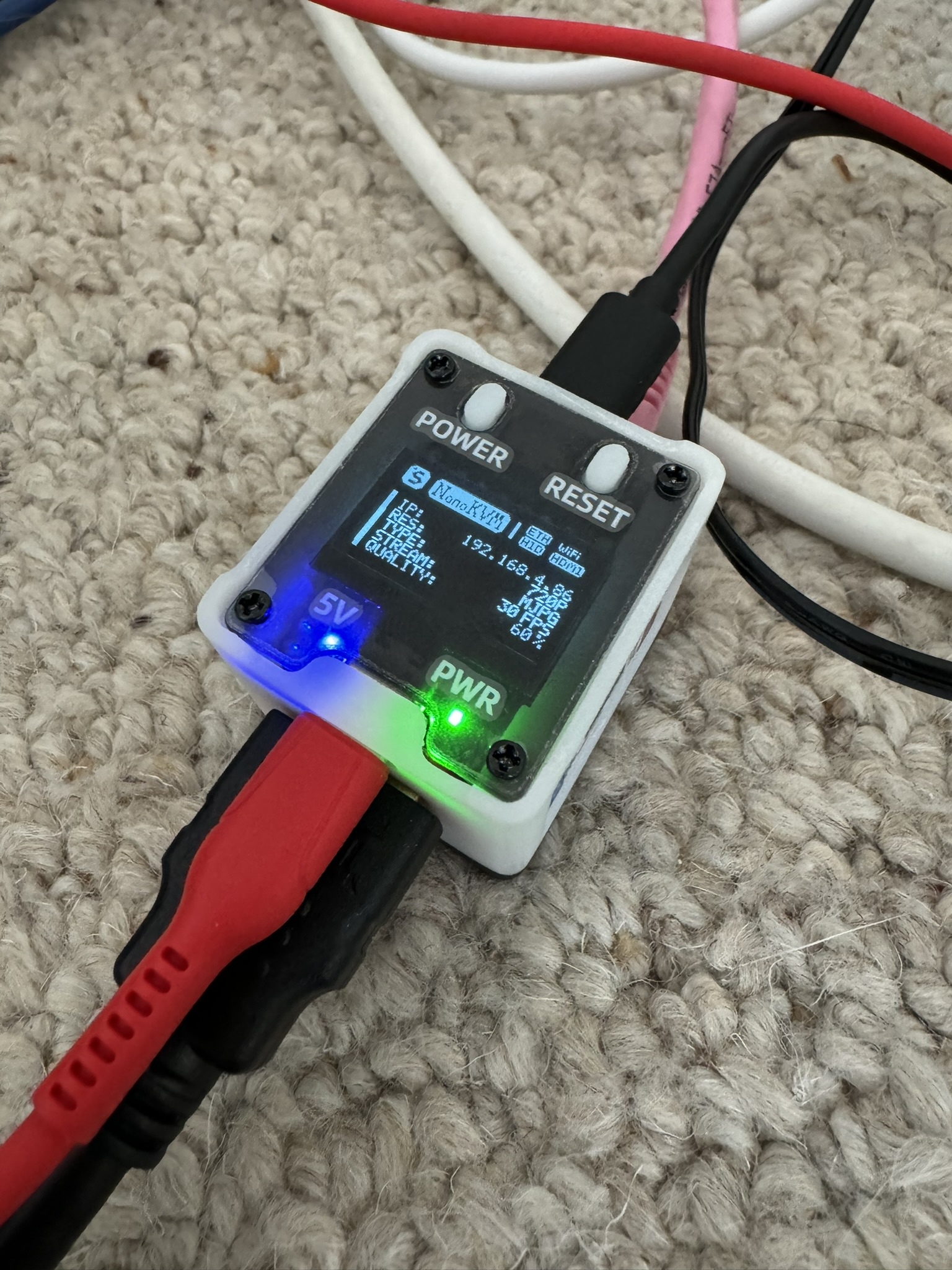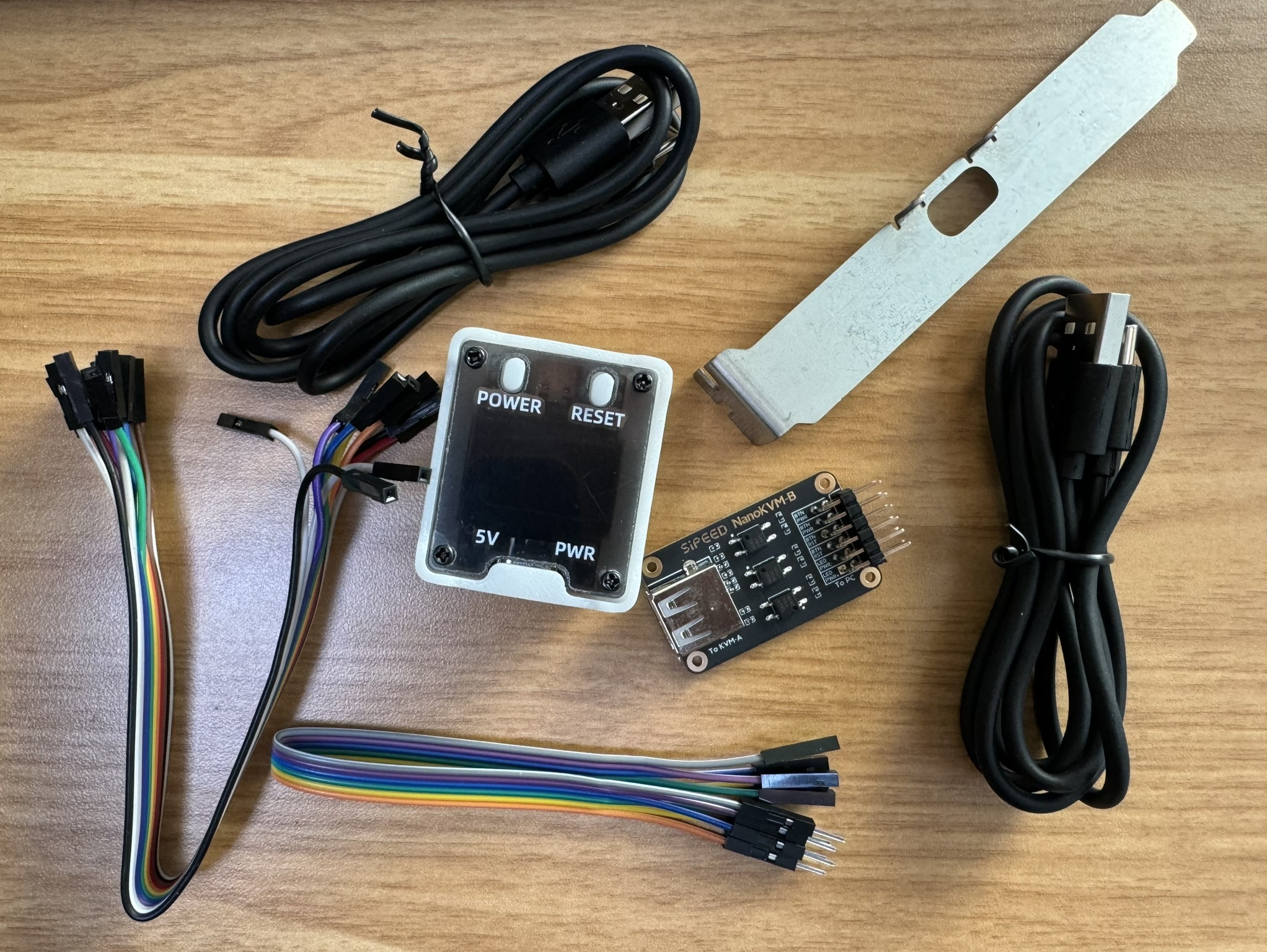Smol KVM
I'm not really sure if I want to own so many computers, but if you want to perform anything like science you need a lot of them. I have a small testbed which I like to say is an experiment in using gaming hardware for doing network science (I can report early that I wish I had enterprise motherboards with lights off management).
Having more machines that I have monitors means that I need some way to manage them independent of switching my monitor to their output. For this reason and so I could work from either home or elsewhere I made sure to buy the only motherboards I could find that had serial ports (thanks Asrock).
I have gotten by sort of coarsely using the serial outputs and the bios feature of power up on AC reset coupled with smart power outlets to give me remote management and a control interface.
This doesn't work very well. I think if the capacitors on the motherboard hold any charge the reset isn't detected, meaning if I forget to power off the smart plug when I shut a machine down I have to do an on/off dance through the smart plug until the machine eventually boots.
The motherboards do not seem to offer the option of sending the bios menu out over serial which I know other machines can do as I have used them. This isn't too much hassle until you add temperamental network cards that require very specific bios configuration to power up. Debugging these issues required me to find a monitor, more keyboards and do a near continuous pull machine rebuild dance for what felt like a year but probably spanned a month or two of 2023.
In a short 300 words, I feel I have a need for a KVM and the spirit of the testbed requires it be cheap.
Options
I know the PiKVM exists, but I can't help think of doing it all myself with FreeBSD every time I consider setting it up and the really surplus Pis I have don't have USB OTG. I have considered building my own USB keyboard connector, but some things I am able to resist doing through sheer will and procrastination.
Recently the Openterface Mini-KVM (oh god is that really the name? I'm going to continue calling it the 'OpenKVM') Crowdsupply crowd funder came by and while I back it, I know I won't get anything for longer than can be planned in. I'm sure this will deliver, Crowdsupply have an exceptional success rate, but hardware is hard and time is sand.
This environment made the super cheap NanoKVM preorder very interesting. Interesting enough to buy one to try out.
NanoKVM
It appeared as a complete surprise this week in quite nice packaging. The device is absolutely tiny with an OLED screen, two buttons and quite a lot of ports. There is Ethernet for network, HDMI for video from the host and 3 USB-C ports; Power, HID and KVM-B (motherboard button header). There are also pin headers to connect up two serial ports for managing things other than PCs.
It is very small and the is completely overwhelmed when you connect all the cables you actually need for it to be useful.
The KVM-B cable connects from USB-C to a break out board, this is then connected to a PCs button headers with jumper cables.
The device powered up on my desk without any trouble, it comes up really quickly. But I haven't run Ethernet yet in the new house and I have no sensible way to offer it a DHCP lease so for testing it is to the attic I must ascend.
Up to the attic I go, plug in the nightmare which is motherboard pin headers in an installed system and power on the device.
With DHCP the little screen shows an acquired IP address matching the alert from my Wifi controller, connecting to this on my phone gives me a black screen.
I climb down the ladder and try from my laptop-desktop, also a black screen, but because computers aren't completely useless like phones is I can inspect the page and see that I have html, but something isn't work.
Up the ladder, poke things, turn off computer, turn on computer using the "Pwr" button on the NanoKVM and it turns on. Try phone again, nothing.
Disconnect NanoKVM from everything, climb down ladder, look at computer and see a login prompt. Look up default creds (admin, admin) and try to login which doesn't work.
Realise the NanoKWM is on my desk disconnected from power.
Climb back up the ladder, reconnect NanoKVM, try phone, get nothing, climb down ladder return to desk. Get a login prompt, log in woo!
My testbed machines boot to Grub and wait for input, this makes dual booting Linux and FreeBSD manageable and you don't have to panic hit a prompt before it times out.
On the KVM I can see the grub menu.
Click on the window and pressing the arrows keys does nothing, bring up the on screen keyboard and using its arrow keys does nothing.
1 frame per connection seems a bit weak, there is an "Update firmware" option in the menu, clicking it offers me to update from 2.0.4 to 2.0.5 I agree. It spins for a while, goes away and now trying to connect gives me just a black screen.
I leave it there for the duration of a meeting about TCP changes in FreeBSD, but nothing.
Pull down attic ladder, climb ladder, unplug NanoKVM power, check the OLED is alive replug power, climb down ladder, stow ladder, reload the page on my laptop-desktop and the NanoKVM is sitting at the login prompt.
Go and buy stuff for supper while the bios times out a check for a peer interface on the 100G card which isn't turned on.
Post update and power cycle and I have enough KVM to watch a boot, log in and type. There is very much latency.
the planet rotates
The next morning I turn my laptop, mount it to the wall in this ridiculous dock I have forced my self to use and try to power on the machine I need to do some work.
The NanoKVM web interface offers three options for button presses, Reset, Power (short click), Power (long click) 8s .
None of these do anything.
I watch the power usage on my energy monitor - nothing. I try to boot the old way, toggling power remotely and nothing. It is 5am, I don't think I can open the attic, pull down the ladder and climb the ladder without waking up the sleeping members of my family.
I click on
Terminal->NanoKVM
Terminal and get a new window that drops me to a
root shell on the KVM itself.
# cat /proc/cpuinfo
processor : 0
hart : 0
isa : rv64imafdvcsu
mmu : sv39
# uname -a
Linux kvm-c12c 5.10.4-tag- #59 PREEMPT Tue Jul 23 20:13:44 PDT 2024 riscv64 GNU/Linux
As a KVM, with an update it seemed okay, not good, not much worse that IPMI interfaces I've used from across the Atlantic. As a device to save me trips to the attic it has failed miserably.
I will probably be better in the future.

